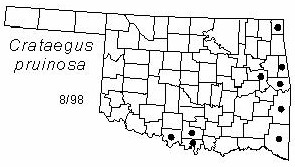Shrub or small tree to 6 m (20 ft) in height and 10 cm (4 in) in diameter. Crown broad, dense and rounded. Bark gray and scaly. Twigs brown, glabrous; spines straight, about 3.8 cm (1.5 in) long. Leaves alternate, simple, deltoid or ovate, 2.5-5 cm (1-2 in) long and 2-4 cm (0.8-1.5 in) wide; glabrous, bluish-green color at maturity and pruinose (having a whitish-powdery secretion on the surface); blunt at base, margins doubly serrate, 6-8 pairs of shallow lobes often present. Flowers in corymbs, glabrous, few on long peduncles; calyx tube obconic, 5-lobed, glabrous; petals 5, white; styles 5; stamens 20, rose colored; flowers appear from April to May. Fruits pomes, 10-15 mm (0.4-0.6 in) diameter, globose; calyx lobes typically deciduous, reddish purple and pruinose; nutlets 5; base rounded, apex acute.; fruits mature in autumn.
Distribution: Oklahoma, Arkansas, Missouri, north to Wisconsin east to Newfoundland, south to North Carolina. Scattered to common in Oklahoma.
Habitat: rocky hillsides and stream valleys.
Comments: Crataegus is from the Greek meaning "flowering thorn"; pruinosa to the waxy, powdery secretion or bloom found on the surface of fruits and leaves which gives a frosted appearance.
Field identification: frosted hawthorn is readily distinguished by the pruinose appearance of the leaves.
Horticultue: frosted hawthorn is rarely used as an ornamental, despite its unique foliage and showy fruits.
Wildlife benefits: In general, the fruits of hawthorn species are eaten by several species of birds. The dense branching pattern provides shelter and nesting habitat for several species of birds.
NWI status: none
Distribution in Oklahoma: 
BACK
NEXT
RETURN TO INDEX
Last update: 9/9/99
 Go to Oklahoma Biological Survey Home Page
Go to Oklahoma Biological Survey Home Page
 Disclaimer
Disclaimer